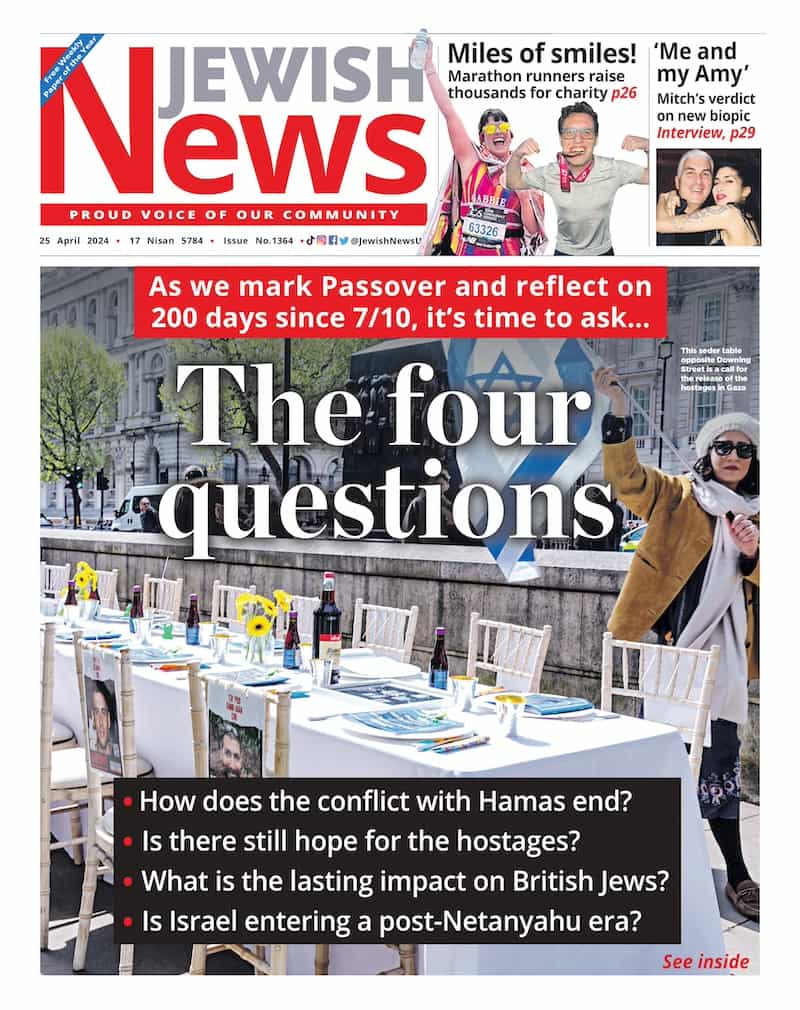A bittersweet history of Jews and chocolate
Self-confessed chocoholic Rabbi Debbie Prinz has travelled far and wide to reveal the Jewish links to this sweet treat in her new book On the Chocolate Trail.
The history of our people just became a whole lot sweeter – thanks to a new book looking at the intriguing links between Jews and chocolate, which launches in the UK on Sunday.
On the Chocolate Trail: A Delicious Adventure Connecting Jews, Religions, History, Travel, Rituals and Recipes to the Magic of Cacao is a mouth -watering exploration of the links between chocolate and the Jewish people over the centuries –and the answer goes far deeper than just the giving of Chanukah gelt.
Get The Jewish News Daily Edition by email and never miss our top stories Free Sign Up
For five years, self-confessed chocoholic Rabbi Debbie Prinz, travelled with her husband, Rabbi Mark Hurvitz, to France, Mexico, Belgium, Israel, Spain, Switzerland (as well as to our very own Cadbury’s) in search of the evidence.

After reviewing archives, diary accounts, merchant ledgers and other historic records, the American-born author was able to piece together the story of how Jews worldwide were involved in the growing, processing, crafting – and eating! – of chocolate.
Rabbi Prinz appears in conversation with Baroness Julia Neuberger at a special event hosted by West London Synagogue on Sunday. There, chocolate-lovers can also try out samples from The Speakeasy Truffle Company, Original Beans and ChocoMe.
In this extract from On the Chocolate Trail, Prinz discovers how, during the Inquisition of 18th Century Mexico, Jewish refugees, conversos and crypto-Jews used chocolate in their rituals:
As I plunged further into these Inquisition reports, I saw that Jews not only took an active role in the cacao trade in the New World, but they also secreted it into their undercover Jewish ritual life. Mexican crypto-Jews used chocolate to welcome the Sabbath because wine was scarce in New Spain. For Jews attempting to follow Jewish dietary laws, the pareve nature of the local chocolate drink prepared without milk lent itself to the separation of milk and meat; it could be enjoyed with a milk meal or a meat meal. Chocolate seeped into these important Jewish customs and celebratory meals for holidays and life-cycle events.
Beatriz Enriquez [Christopher Columbus’ mistress] and her sister would not even drink their daily chocolate until they had prayed each morning. Beatriz recalled that, following the private negotiations for an engagement, the entire family joined together for chocolate drinking.
This chocolate use extended to sad times as well. Holding vigil for the dying Doňa Blanca Mendez de Rivera, her daughters and granddaughters spent a day in reflection and prayer, fortified by a special meal of chocolate and pickled fish brought from Veracruz by the merchant Mathias Rodriguez de Olivera, as Margarita de Rivera recalled for the Inquisition (1644).
The proceedings of Gabriel de Granada’s trial (October 1642) report his testimony about the mourning period for his
father, Manuel de Granada: “Gabriel sent to her the hard boiled eggs and chocolate which was eaten by the said widow and her children. During the six days preceding the said seventh, sent chocolate one day of the said six.”At funerals, the Mexican Vaez family (16305) ate chocolate, raisins, almonds, salad, and homemade bread, but never any meat. Chocolate even accompanied meals associated with the beginning and end of the fast of Yom Kippur. This holy day may have been the most frequently observed, so much so many secret Jews even risked writing down the exact date. The theme of atonement resonated, as they felt themselves sinning through their public profession of Catholicism. Rosh Hashanah was rarely commemorated, given its celebratory meals and rituals.
Gaspar Vaez broke his 1640 Yom Kippur fast with chocolate, eggs, salad, pies, fish, and olives. Isabel de Rivera testified on 7 October 1642, that a year before, on Yom Kippur, Doňa Juana, who was married to the wealthy Simon Vaez Sevilla, sent “thick chocolate and sweet things made in her house”. Around 1645, Gabriel de Granada and his family washed down their pre-fast meal with chocolate, having dined on fish, eggs, and vegetables. Others reported they preceded the Day of Atonement with fruit and chocolate and that they broke the fast with chocolate and similar treats.
Beatriz Enriquez, at the age of 22, testified that when her husband left for long business trips, she took advantage of her sadness to hide her abstinence from chocolate and food on Yom Kippur: “From the window she pretended to be crying over the absence of her husband and was able to hide from her negras (Negro servants) the fact she ate nothing and did not drink chocolate that day.”
So as not to eat on fast days, Amaro Diaz Martarana and her husband would stage a falling out with each other in the middle of the day. When chocolate was brought to them, they would pretend to be offended and spill it on the servants. They reconciled in the evening…”
On the Chocolate Trail: A Delicious Adventure Connecting Jews, Religions, History, Travel, Rituals and Recipes to the Magic of Cacao by Rabbi Deborah R. Prinz, published by Jewish Lights Publishing, is out now. To book a place at Sunday’s event at West London Synagogue, email Kathryn Forro at kathryn.forro@wls.org.uk or call 020 7535 0259

Thank you for helping to make Jewish News the leading source of news and opinion for the UK Jewish community. Today we're asking for your invaluable help to continue putting our community first in everything we do.
For as little as £5 a month you can help sustain the vital work we do in celebrating and standing up for Jewish life in Britain.
Jewish News holds our community together and keeps us connected. Like a synagogue, it’s where people turn to feel part of something bigger. It also proudly shows the rest of Britain the vibrancy and rich culture of modern Jewish life.
You can make a quick and easy one-off or monthly contribution of £5, £10, £20 or any other sum you’re comfortable with.
100% of your donation will help us continue celebrating our community, in all its dynamic diversity...
Engaging
Being a community platform means so much more than producing a newspaper and website. One of our proudest roles is media partnering with our invaluable charities to amplify the outstanding work they do to help us all.
Celebrating
There’s no shortage of oys in the world but Jewish News takes every opportunity to celebrate the joys too, through projects like Night of Heroes, 40 Under 40 and other compelling countdowns that make the community kvell with pride.
Pioneering
In the first collaboration between media outlets from different faiths, Jewish News worked with British Muslim TV and Church Times to produce a list of young activists leading the way on interfaith understanding.
Campaigning
Royal Mail issued a stamp honouring Holocaust hero Sir Nicholas Winton after a Jewish News campaign attracted more than 100,000 backers. Jewish Newsalso produces special editions of the paper highlighting pressing issues including mental health and Holocaust remembrance.
Easy access
In an age when news is readily accessible, Jewish News provides high-quality content free online and offline, removing any financial barriers to connecting people.
Voice of our community to wider society
The Jewish News team regularly appears on TV, radio and on the pages of the national press to comment on stories about the Jewish community. Easy access to the paper on the streets of London also means Jewish News provides an invaluable window into the community for the country at large.
We hope you agree all this is worth preserving.
-
By Brigit Grant
-
By Laurent Vaughan - Senior Associate (Bishop & Sewell Solicitors)
-
By Laurent Vaughan - Senior Associate (Bishop & Sewell Solicitors)
-
By Laurent Vaughan - Senior Associate (Bishop & Sewell Solicitors)
-
By Laurent Vaughan - Senior Associate (Bishop & Sewell Solicitors)
























